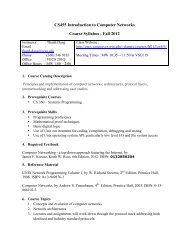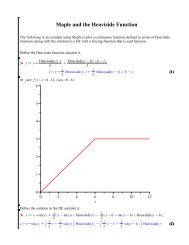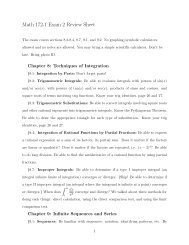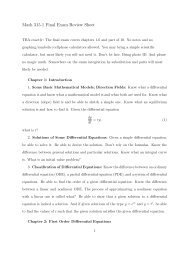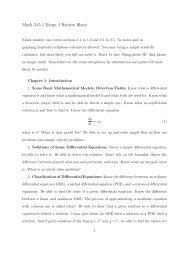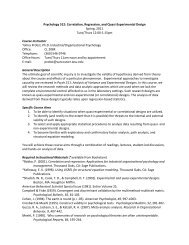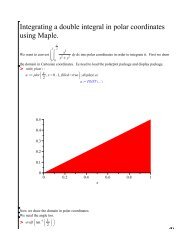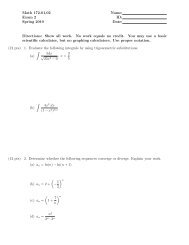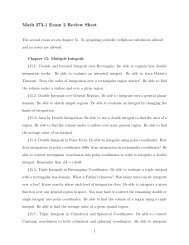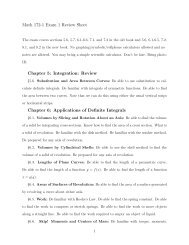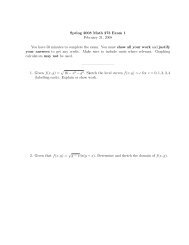Spring 2008 Math 273 Review for Final Exam 1. review all earlier ...
Spring 2008 Math 273 Review for Final Exam 1. review all earlier ...
Spring 2008 Math 273 Review for Final Exam 1. review all earlier ...
Create successful ePaper yourself
Turn your PDF publications into a flip-book with our unique Google optimized e-Paper software.
• 12.5 14: ∇f = 2i + 4j − 6k ⇒ (D u f) P0 = ∇f · u = 03(h) Find direction and magnitude of maximum rate of change 18, 19• 12.5 18: ∇f(1, 0) = 2j ⇒ u = j. f increases most rapidly in the direction of jand decreases most rapidly in the direction of −j.(i) 12.6 Linearisation of f(x, y) 29, 41; Computing error 47;(j) Find the equation of the tangent plane to the surface z = f(x, y) at the pointP = (x 0 , y 0 , z 0 ). 10, 11• 12.6 10: z = 1(k) 12.7 Given z = f(x, y). Find the relative maximum and minimum points andsaddle points (if there are any). Show why they are max or min. 14, 17, 19, 27,47. Chapter <strong>review</strong> 60, 61• 12.7 14: Local minimum of f(x, y) is f(1, 0) = 0• 12.7 60: Saddle point at f(0, −1) = 2(l) 12.8 Use method of Lagrange multipliers to find extrema satisfying one givenconstraint. In particular, find point closest to a given surface. 17, 195. Chapter 13(a) 13.1 Double integrals over a given rectangular region. Focus on deciding whichorder of integration is simpler. 10, 16, 17, 18• 13.1 10:• 13.1 16:• 13.1 18:∫ 1 ∫ 20∫∫R∫∫R1xye x dydx =y sin(x + y) dA =xye xy2 dA =∫ 1∫ 2 ∫ 1032 xex dx = 3 20∫ 0 ∫ π0−π0y sin(x + y) dydx = 4xye xy2 dydx = 1 2 (e2 − 3)(b) 13.2 Double integrals over general regions: Focus on finding new limits when reversingorder of integration. 18, 19, 20, 27, 28, 29• 13.2 18:∫ 1 ∫ √ 1−y0 1−ydxdy
• 13.2 20:• 13.2 28:∫ 2 ∫ ln x1 0∫ 2 ∫ 4−x 200dydxxe 2y ∫ 44 − y dydx =0∫ √ 4−y0xe 2y4 − y dxdy = e8 − 144(c) 13.3 Average value of a function, area of a region 12, 15• 13.3 12:∫ 2 ∫ y+2−1y 2 dxdy = 9 2(d) 13.4 Converting integrals from rectangular to polar coordinates and evaluatingpolar integrals 3, 7, 14, 18, 19• 13.4 14:∫ 2 ∫ 0• 13.4 18: Area = 20xy−√1−(y−1) 2 dxdy =2∫ π/6 ∫ 1+cos θ01∫ ππ/2∫ 2 sin θ0r drdθ = 12πsin 2 θ cos θr 4 drdθ = − 4 5(e) 13.5 (No changing order of integration) • triple integrals 14, 27, 32• 13.5 14: 16/3• 13.5 32: Volume =∫ 2 ∫ √ 4−x ∫ 2 3−x−2 − √ 4−x 2 0dzdydx = 12π(f) 13.7 Focus on spherical coordinates. • 37, 38, Chapter <strong>review</strong> 33• 13.7 38: Volume =(g) 13.8 Computing Jacobians∫ 2π ∫ π/2 ∫ 20π/30ρ 2 sin φ dρdφdθ = 8π 3i. • Find the Jacobian of the trans<strong>for</strong>mation from (x, y) −→ (u, v) given thatx = e u+v and y = e u−vJacobian = −2e 2uii. • Find the Jacobian of the trans<strong>for</strong>mation from (x, y) −→ (u, v) given thatx = 5u − v and y = u + 3vJacobian = 16iii. • Find the Jacobian of the trans<strong>for</strong>mation from (x, y) −→ (u, v) given thatx = uv and y = u v
5Jacobian = −2uviv. • Find the Jacobian of the trans<strong>for</strong>mation from (x, y, z) −→ (u, v, w) giventhatx = v + w 2 and y = w + u 2 and z = u + v 2Jacobian = −2 + 8uvw6. Chapter 14: Vector Fields(a) (14.3 1 — 6) Determine whether F is a conservative field.(b) (14.3 1 — 6) Compute div and curl <strong>for</strong> a vector field F.• 14.3 1: Conservative. div F = 0, curl F = 0• 14.3 2: Conservative. div F = −xy sin z, curl F = 0• 14.3 3: Not conservative. div F = 0, curl F = −2i• 14.3 4: Not conservative. div F = 0, curl F = 2k• 14.3 5: Not conservative. div F = 0, curl F = −k• 14.3 6: Conservative. div F = e x cos y − e x cos y + 1, curl F = 0(c) 14.3 Find a potential function <strong>for</strong> F. 7 — 9• 14.3 8:f(x, y, z) = xy + xz + yz + C



